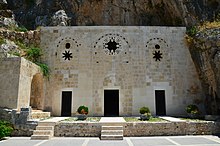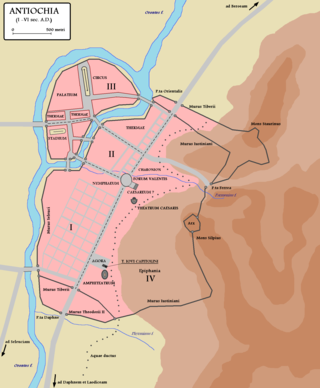
Antioch on the Orontes was a Hellenistic Greek city founded by Seleucus I Nicator in 300 BC. It was one of the greatest and most important Greek cities of the Hellenistic period. The city served as the capital of the Greek Seleucid Empire and later as regional capital to both the Roman and Byzantine Empire. During the Crusades, Antioch served as the capital of the Principality of Antioch, one of four Crusader states that were founded in the Levant. The modern city of Antakya, in Hatay Province of Turkey, was named after the ancient city, which lies in ruins on the Orontes River and did not overlap in habitation with the modern city.
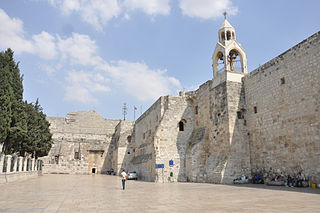
The Church of the Nativity, or Basilica of the Nativity, is a basilica located in Bethlehem, West Bank, Palestine. The grotto holds a prominent religious significance to Christians of various denominations as the birthplace of Jesus. The grotto is the oldest site continuously used as a place of worship in Christianity, and the basilica is the oldest major church in the Holy Land.

Cilicia was a geographical region in southern Anatolia, extending inland from the northeastern coasts of the Mediterranean Sea. Cilicia has a population ranging over six million, concentrated mostly at the Cilicia plain. The region includes the provinces of Mersin, Adana, Osmaniye and Hatay.
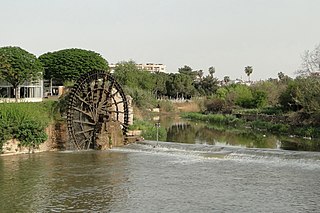
The Orontes or Asi is a 571 kilometres (355 mi) long river in Western Asia that begins in Lebanon, flowing northwards through Syria before entering the Mediterranean Sea near Samandağ in Hatay Province, Turkey.

The Papal Basilica of Saint Paul Outside the Walls is one of Rome's four major papal basilicas, along with the basilicas of Saint John in the Lateran, Saint Peter's, and Saint Mary Major, as well as one of the Seven Pilgrim Churches of Rome.

İskenderun, historically known as Alexandretta and Scanderoon, is a municipality and district of Hatay Province, Turkey. Its area is 247 km2, and its population is 251,682 (2022). It is on the Mediterranean coast. Located on an alluvial plain, the city was heavily damaged by powerful earthquakes in February 2023 and subsequent aftershocks, floods and fires.
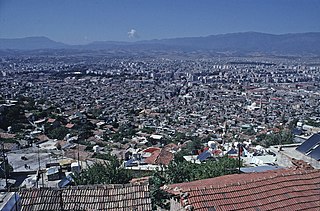
Antakya, modern form of Antioch, is a municipality and the capital district of Hatay Province, Turkey. Its area is 703 km2, and its population is 399,045 (2022). It is the capital of Hatay Province, the southernmost province of Turkey. The city is located in a well-watered and fertile valley on the Orontes River, about 20 kilometres (12 mi) from the Levantine Sea.

Hatay Province is the southernmost province and metropolitan municipality of Turkey. Its area is 5,524 km2, and its population is 1,686,043 (2022). It is situated mostly outside Anatolia, along the eastern coast of the Levantine Sea. The province borders Syria to its south and east, the Turkish province of Adana to the northwest, Osmaniye to the north, and Gaziantep to the northeast. It is partially in Çukurova, a large fertile plain along Cilicia. Its administrative capital is Antakya, making it one of the three Turkish provinces not named after its administrative capital or any settlement. The second-largest city is İskenderun. Sovereignty over most of the province remains disputed with neighbouring Syria, which claims that the province had a demographic Arab majority, and was separated from itself against the stipulations of the French Mandate of Syria in the years following Syria's occupation by France after World War I.
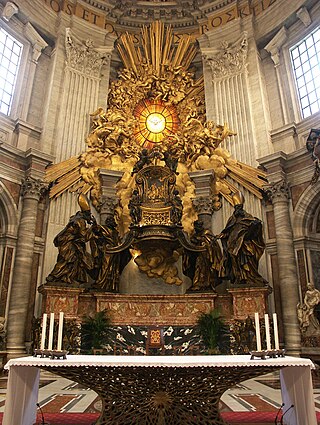
The Chair of Saint Peter, also known as the Throne of Saint Peter, is a relic conserved in St. Peter's Basilica in Vatican City, the sovereign enclave of the Pope inside Rome, Italy. The relic is a wooden throne that tradition claims belonged to the Apostle Saint Peter, the leader of the Early Christians in Rome and first Pope, and which he used as Bishop of Rome. The relic is enclosed in a sculpted gilt bronze casing designed by Gian Lorenzo Bernini and constructed between 1647 and 1653. In 2012, Pope Benedict XVI described the chair as "a symbol of the special mission of Peter and his Successors to tend Christ's flock, keeping it united in faith and in charity."

The St. Mark's Church or the Church of St. Mark is a Serbian Orthodox church located in the Tašmajdan park in Belgrade, Serbia, near the Parliament of Serbia. It was built in the Serbo-Byzantine style by the Krstić brothers, completed in 1940, on the site of a previous church dating to 1835. It is one of the largest churches in the country. There is a small Russian church next to St. Mark's.

The Hatay Archaeology Museum is the archaeology museum of Antakya, Turkey. It is known for its extensive collection of Roman and Byzantine Era mosaics. The museum is located in Antakya, the main city of Hatay. Construction of the museum started in 1934 on the recommendation of the French archaeologist and antiquities inspector Claude M. Prost. It was completed in 1938 and came under Turkish control in 1939 following Hatay's unification with Turkey. The museum was opened to the public in 1948 and re-opened in 1975 following renovation and expansion.

Samandağ, formerly known as Süveydiye, is a municipality and district of Hatay Province, Turkey. Its area is 384 km2, and its population is 123,447 (2022). It lies at the mouth of the Asi River on the Mediterranean coast, near Turkey's border with Syria, 25 km (16 mi) from the city of Antakya. In February 2023, the town was heavily damaged by powerful earthquakes.

Church of Saint Peter in Gallicantu is a Roman Catholic church located on the eastern slope of Mount Zion, just outside the walled Old City of Jerusalem, Israel. It is dedicated to the episode from the New Testament known as the Denial of Peter.
The Antakya Synagogue is located in Antakya, Turkey near the border with Syria. It served the few remaining members of the once thriving, 2,300-year-old Jewish community of ancient Antioch, and which was one of the world's oldest Jewish communities, that by 2014, had shrunk to fewer than 20 members.

Harbiye is a neighbourhood of the municipality and district of Defne, Hatay Province, Turkey. Its population is 27,057 (2022). Before the 2013 reorganisation, it was a town (belde). Also in 2013, it passed from the former central district of Hatay to the new district of Defne.

The Antioch mosaics are a grouping of over 300 mosaic floors created around the 3rd century AD, and discovered during archaeological excavations of Antioch between 1932 and 1939 by a consortium of five museums and institutions. About half of the mosaics are now in the Hatay Archaeology Museum in Antakya, with the rest in the Worcester Art Museum, Museum of Fine Arts, Boston, Baltimore Museum of Art, Harvard University and Princeton University Art Museum among others. The mosaics range in design from realistic imagery and scenes to purely geometric patterns.

The Anglican Church of St. John the Evangelist, also known simply as St. John's, is located in İzmir, Turkey, in the quarter of Alsancak.

The Monastery of Saint Simeon Stylites the Younger is a former Christian monastery that lies on a hill roughly 29 kilometres southwest of Antakya and six kilometres to the east of Samandağ, in the southernmost Turkish province of Hatay. The site is extensive but the monastery buildings are in ruins.
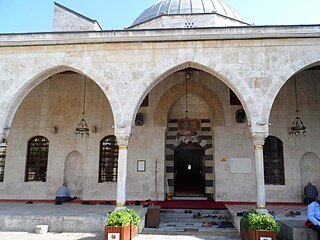
Habib-i Nejjar Mosque is a historical mosque in Antakya, Hatay Province, Turkey named after Habib the Carpenter. The mosque is to the east of Orontes River. The mosque was severely damaged by earthquakes in February 2023.

St. Paul's Church is a historic Greek Orthodox church in Antakya, Turkey. It is a member of the Greek Orthodox Patriarchate of Antioch. It was largely destroyed in the 2023 Turkey–Syria earthquake.
